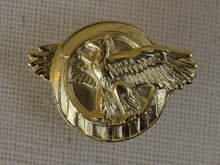Honorable Service Lapel Button

The Honorable Service Lapel Button, sometimes called the Honorable Service Lapel Pin, was awarded to United States military service members who were discharged under honorable conditions during World War II.[1] The award is sometimes colloquially called the Ruptured Duck.[2] Sculptor Anthony de Francisci designed the award.
The Department of Defense awarded the button between September of 1939 and December of 1946, and it was made of gilt brass, except during metal shortages during which it was made of gilt plastic. Service members who received the plastic version were later allowed to trade it in for the brass version.
Design and wear

The button is approximately 7/16 inch in height and 5/8 inch in width. A cloth lozenge depicting the gold colored button design was also issued. The lozenge was approximately 1.5 inches in height and 3 inches in width with the ring design being approximately 1 inch in diameter. Honorably discharged veterans wore the lapel pin on the left lapel of civilian clothing and the lozenge was sewn onto the right breast of the dress uniform that they wore when being discharged.[1]
Even though the button depicts an eagle, the design of the eagle itself seems to depict its breast bursting through the button as though it has ruptured, and the eagle was believed to have been so poorly designed as to resemble a duck rather than an eagle; the term "ruptured duck" was coined to refer to it on those bases.
Purpose
The award served several purposes. It served as proof that the wearer was an honorably discharged veteran returning from duty. Unofficially, it was also used as an identifier to railroad, bus, and other transportation companies who offered free or subsidized transportation to returning veterans.
During World War II, members of the armed forces were forbidden to possess civilian clothing unless they were under specific orders to do so. This not only made desertion more difficult, but also ensured that any captured service member would be treated as a prisoner of war under the rules of war. (Soldiers captured in combat zones in possession of civilian clothing were liable to be treated as spies and summarily executed.) In pre-war conditions, discharged veterans typically donned civilian clothing when returning home, but this was logistically difficult during wartime and immediate post-war America. Approximately 16 million men and women served in the uniformed services during the crisis, most of whom were scheduled to be discharged within a short period of time during the general demobilization at the end of the war. Clothing was already in short supply due to cloth rationing, and the immediate clothing needs of millions of returning veterans threatened to crash an already overtaxed system. Federal law, however, prevented civilians, even veterans, from wearing military uniforms under most circumstances. The Honorable Service Lapel Button was created to allow returning veterans to continue, legally, to wear their military uniforms while, at the same time, signifying that they had ceased to be active duty personnel.
The discharge insignia, embroidered onto a cloth lozenge and sewn on the right breast of the tunic, allowed its wearer to continue to wear his or her uniform for up to thirty days subsequent to discharge. Some veterans wore the pin on their civilian lapels for many years after the end of the war. It also appeared on a postage stamp honoring veterans, and is widely used as an unofficial symbol of veterans's pride.
The usage of the term "ruptured duck" later expanded to also refer to individuals wearing it, as in "that ruptured duck is flying space-available." Presumably because these individuals were usually in a great hurry to return to their homes in the United States, the term later came into use when describing somebody or something which was moving quickly.
See also
- Service lapel button (disambiguation)
- List of participating aircraft in Doolittle Raid — "The Ruptured Duck"
References
- 1 2 "Honorable Service Lapel Button". Army Heraldry. The Institute of Heraldry. Retrieved 2014-07-17.
- ↑ Talento, Catherine. "WWII veteran's artwork lives on at museum." Air Force News Agency, 25 April 2007. Retrieved: 10 February 2008. Archived November 20, 2007, at the Wayback Machine.
External links
| Wikimedia Commons has media related to Honorable Service Lapel Button. |
- "Honorable Service Lapel Button and Honorable Discharge Emblem" (Description of the award by the United States Army Institute of Heraldry)
- "Soldier for Life Lapel Button" (Description of the award by the United States Army Institute of Heraldry. As of 29 June 2014, the Soldier for Life logo is used for both the US Army Retired Lapel Button for retirees and the Army Lapel Button for veterans. Army Lapel Button is awarded to active duty and ready reserve members for a minimum of 9 months continuous active Federal service in the US Army who receive an Honorable Discharge, pursuant to Army Regulation for Military Awards, AR 600–8–22, 25 June 2015, paragraph 6-17)